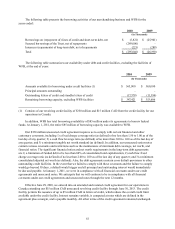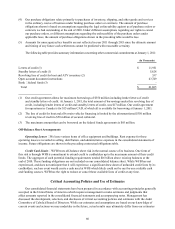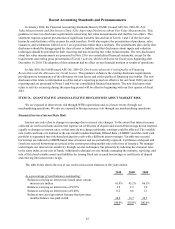Cabela's 2010 Annual Report Download - page 73
Download and view the complete annual report
Please find page 73 of the 2010 Cabela's annual report below. You can navigate through the pages in the report by either clicking on the pages listed below, or by using the keyword search tool below to find specific information within the annual report.
63
Recent Accounting Standards and Pronouncements
In January 2010, the Financial Accounting Standards Board (“FASB”) issued ASU No. 2010-06, Fair
Value Measurements and Disclosures (Topic 820): Improving Disclosures about Fair Value Measurements. This
guidance revises two disclosure requirements concerning fair value measurements and clarifies two others. This
statement requires separate presentation of significant transfers into and out of Levels 1 and 2 of the fair value
hierarchy and disclosure of the reasons for such transfers. It will also require the presentation of purchases, sales,
issuances, and settlements within Level 3 on a gross basis rather than a net basis. The amendments also clarify that
disclosures should be disaggregated by class of asset or liability and that disclosures about inputs and valuation
techniques should be provided for both recurring and non-recurring fair value measurements. The new disclosures
about fair value measurements are presented in Note 25 to our consolidated financial statements, except for the
requirement concerning gross presentation of Level 3 activity, which is effective for fiscal years beginning after
December 15, 2010. The adoption of this statement had no effect on our financial position or results of operations.
In July 2010, the FASB issued ASU No. 2010-20, Disclosures about the Credit Quality of Financing
Receivables and the Allowance for Credit Losses. This guidance enhances the existing disclosure requirements
providing more transparency of the allowance for loan losses and credit quality of financing receivables. The new
disclosures that relate to information as of the end of a reporting period are effective for our fiscal 2010 year-end
reporting and are presented in Notes 1 and 4 to our consolidated financial statements. The new disclosures that
relate to activity occurring during the reporting period will be effective beginning with our first quarter of fiscal
2011.
ITEM 7A. QUANTITATIVE AND QUALITATIVE DISCLOSURES ABOUT MARKET RISK
We are exposed to interest rate risk through WFB’s operations and, to a lesser extent, through our
merchandising operations. We also are exposed to foreign currency risk through our merchandising operations.
Financial Services Interest Rate Risk
Interest rate risk refers to changes in earnings due to interest rate changes. To the extent that interest income
collected on credit card loans and interest expense on certificates of deposit and secured borrowings do not respond
equally to changes in interest rates, or that rates do not change uniformly, earnings could be affected. The variable
rate credit card loans are indexed to the one month London Interbank Offered Rate (“LIBOR”) and the credit card
portfolio is segmented into risk-based pricing tiers each with a different interest margin. Variable rate secured
borrowings are indexed to LIBOR-based rates of interest and are periodically repriced. Certificates of deposit and
fixed rate secured borrowings are priced at the current prevailing market rate at the time of issuance. We manage
and mitigate our interest rate sensitivity through several techniques, but primarily by indexing the customer rates
to the same index as our cost of funds. Additional techniques we use include managing the maturity, repricing, and
mix of fixed and variable assets and liabilities by issuing fixed rate secured borrowings or certificates of deposit
and entering into interest rate swaps.
The table below shows the mix of our credit card account balances at the years ended:
2010 2009 2008
As a percentage of total balances outstanding:
Balances carrying an interest rate based upon various
interest rate indices 61.9%65.2%66.1%
Balances carrying an interest rate of 9.99% 3.9 2.5 1.9
Balances carrying an interest rate of 0.00% 0.2 0.6 1.3
Balances not carrying interest because their previous
month’s balance was paid in full 34.0 31.7 30.7
100.0%100.0%100.0%
























